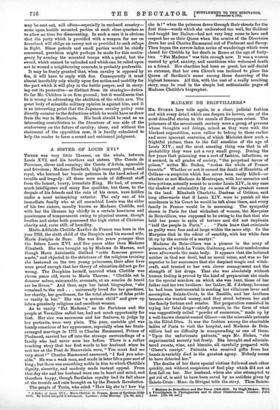A SISTER OF LOUIS XVL*
THERE was very little likeness, on the whole, between Louis XVI. and his brothers and sisters. The Comte de Provence, clever and cunning; the Comte d'Artois, agreeable and frivolous ; Madame Elisabeth, high-tempered, proud, and royal, who learned her heroic patience in the hard school of trouble and tragedy : all these were made of different stuff from tho honest, heavy, irresolute King. He had, of course, much intelligence and many fine qualities, but these, to the despair of his friends and the ruin of his cause, were hidden under a most uninspiring exterior. The only one of his immediate family who at all resembled Louis was the elder of his two sisters, usually known as Madame Clotilde, and with her the likeness lay chiefly in a certain heaviness and passiveness of temperament owing to physical causes, though brother and sister both possessed the high virtue of Christian charity and, rarer still, of humility.
Marie-Adelaide-Clotilde-Xaviere de France was born in the year 1759, the sixth child of the Dauphin and his second wife, Marie Josephe de Saxe. She was five years younger than the future Louis XVI. and five years older than Madame Elisabeth. She was brought up by Madame de Masan, and though Marie Antoinette disliked " cette fameuse gonver- nante," and objected to the strictness of the religious training she bestowed on the two young princesses, their after lives were proof enough that her theory of education did not go far wrong. The Dauphine herself, married when Clotilde was eleven years old, wrote to Maria Theresa : "Clotilde est la donceur meme, raisonnable, avenante, et un sourire de bonte our les levres." And thus, says her latest biographer, "she remained to the end . . . universally loved for her goodness, her charity, her gentleness, for the total absence of false pride or vanity in her." She was " a serious child" and grew up into a genuinely religious and excellent woman.
As to vanity "Fat Madame," as the Parisians and the people at Versailles called her, had not much opportunity for that. Her size was enormous and her features, to judge by her portraits, were very plain. The poor, amiable girl was keenly conscious of her appearance, especially when her State- arranged marriage in 1775 to Charles Emmanuel, Prince of Piedmont, carried her off into the strange surroundings of a family who had never seen her before. There is a rather touching story that her first words to her husband when he met her at the Pont de Beauvoisin were, "You must find me very stout I " Charles Emmanuel answered, "I find you ador- able." He was a weak man, and made in later life a poor sort of king ; but there was something noble in him to which Clotilde's dignity, sincerity, and modesty made instant appeal. From that day she and her husband were one in heart and mind, and therefore happy, though Sardinian royalty had its full share of the trouble and ruin brought on by the French Revolution.
The people of Turin, who cried. "How big she is ! how big
A Sister of Louis MU.: Maris-Clotilde de Frames, Queer. of Sardinia (1759- 1832). By Louis Leopold d'Arteinont. London: John Murray. [7s. 6d. net.]
she is !" when the princess drove through their streets for the first time—words which she understood too well, for Goldoni had taught her Italian—had not very long come to love and respect her as their Queen when the armies of the Directoire drove her and Charles Emmanuel out of Piedmont and Savoy. Then began the sorrow-laden series of wanderings which were closed for Clotilde by her death in Rome at the age of forty- two. "Fat Madame" was thin enough now. It was a woman wasted by grief, anxiety, and asceticism who welcomed death as a friend. Her charities had been so great, her self-denial so extreme, that her own Church was inclined to place the Queen of Sardinia's name among those deserving of the highest honours. All this, with the rest of a really touching story, may be read in the simple but enthusiastic pages of Madame Clotilde's biographer.






































































 Previous page
Previous page